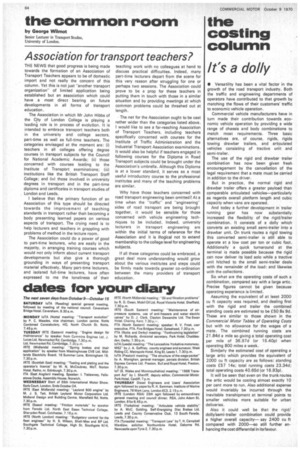the costing column It's a dolly
Page 66

If you've noticed an error in this article please click here to report it so we can fix it.
• Versatility has been a vital factor in the growth of the road transport industry. Both the traffic and engineering departments of operators have contributed to that growth by matching the flows of their customers' traffic to economic vehicle operation.
Commercial vehicle manufacturers have in turn made their contribution towards economic vehicle operation by providing a wide range of chassis and body combinations to match most requirements. Three basic alternatives are, of course, rigids, rigids towing drawbar trailers, and articulated vehicles consisting of tractive unit and semi-trailer.
The use of the rigid and drawbar trailer combination has now been given fresh encouragement by the cancellation of the legal requirement that a mate must be carried in addition to the driver.
But in practice, the normal rigid and drawbar trailer offers a greater payload than comparable articulated vehicles—particularly as regards overall platform length and cubic capacity when vans are operated.
And today a further development in trailer running gear has now substantially increased the flexibility of the rigid/trailer combination. It consists of a dolly which converts an existing small semi-trailer into a drawbar unit. On trunk routes a rigid towing this converted semi-trailer is still able to operate at a low cost per ton or cubic foot. Additionally a quick turnaround at the terminal is made possible because the rigid can now deliver its load solo while a tractive unit hitched to the small semi-trailer deals with the remainder of the load: and likewise with the collections.
So what are the operating costs of such a combination, compared say with a large artic. Precise figures cannot be given because operating experience is limited.
Assuming the equivalent of at least 2000 cu ft capacity was required, and dealing first with the rigid and trailer the combined standing costs are estimated to be £50 8s 9d. These are similar to those shown in the Commercial Motor Tables of Operating Costs but with no allowance for the wages of a mate. The combined running costs are 21.84d a mile so giving a total operating cost per mile of 36.97d (or 15.40p) when operating 800 miles a week.
Similarly the estimated cost of operating a large artic which provides the equivalent of 2000 cu ft capacity are as follows: standing costs £57 14s; total running costs 23.34d; total operating costs 40.65d (or 16.93p).
It will be seen that even on the trunk routes the artic would be costing almost exactly 10 per cent more to run. Also additional expense would invariably be incurred through the inevitable transhipment at terminal points to smaller vehicles more suitable for urban deliveries.
Also it could well be that the rigid/ dolly/semi-trailer combination could provide a higher overall capacity— say 2400 Cu ft compared with 2000—so still further enhancing the cost differential in itsfavour.








































































































